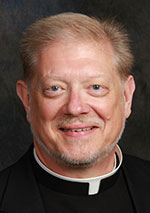That All May Be One / Fr. Rick Ginther
Tragedy offers ‘teachable moment’ about Sikh community
 As a teacher, I love “teachable moments.”
As a teacher, I love “teachable moments.”
Students learn quicker when an event or question challenges them. Leading them in the “moment” grants them multiple levels to grasp understanding, knowledge, even wisdom.
The May 1 memorial service at Lucas Oil Stadium in Indianapolis for the victims of the April 15 mass shooting at the FedEx Ground Plainfield Operations Center in Indianapolis provided, sadly, a “teachable moment” for Christians. Four of the victims were of the local Sikh faith community.
Sikhism originated in the Punjab region of northwest India, and the religion arose near the end of the 15th century. With 25-30 million adherents, it is one of the youngest major religions and the fifth largest organized religion worldwide.
“Sikh” best translates as “disciple,” “seeker” or “learner.” The “teacher” is a guru.
After a succession of 10 gurus, the last, Gobind Singh, named the Sikh scripture “Guru Granth Sahib” as his successor. The line of human gurus ceased, and the scripture became the eternal, religious spiritual guide.
The scripture opens with the “Mul Mantar,” a fundamental prayer about the “one God.”
Sikhism is considered to be monotheistic. While it is true that Sikhism does honor several “deities” from the Hindu pantheon, they are “honored,” not worshipped. Only the one God is worshipped. “One” is the central characteristic of the divine.
The core beliefs of Sikhism find its foundation in the name of the one creator. Sikhs are called to faith and mediation upon this name.
From such reflection, the divine unity reveals the belief in the equality of all humankind (in marked contrast to the caste system of Hinduism).
From the equality of all humankind arises selfless service and striving for justice for the benefit and prosperity of all.
Honest conduct and livelihood are the bedrock for selflessness and justice.
Sikhism has respect for all religions and champions religious liberty.
Sikhism, as many religions, arose as a contrast to other religions (for example, Mughul Islam and Hinduism).
It has experienced periods of persecution from the time of its inception to the present. These periods of persecution have resulted in a diaspora to the West (England, Canada, U.S. and Italy). But 83% of Sikhs, however, remain in India, especially the state of Punjab.
There are symbols that an observant “Khalsa Sikh” wears to show their commitment to the Sikh way of life. The symbols are physical statements of their faith.
Known as the five “K’s,” they are worn at all times. Kesh (uncut hair), Kangha (wooden comb), Kara (iron bracelet), Kachaera (a 100% cotton undergarment) and Kirpan (an iron dagger to defend oneself or a defenseless person).
The unique “turban” worn over the Kesh is called a “dastar.” One can see these worn by men on their jobs, at worship and at home. They are quite evident at the Festival of Faiths in Indianapolis each year.
A “gurdwara” (door to the guru) is where Sikhs assemble for worship. In keeping with the tenet of faith that all people are equal, all faiths are welcomed in gurdwaras.
Their scripture is enthroned on a “takhat,” in a prominent central position known as the “Darbar Sahib.” Scripture verses are recited or sung with explanations for the congregation.
All gurdwaras have a “langar” hall, where people can eat free vegetarian food served by volunteers.
There are five gurdwaras in the archdiocese: three in Indianapolis, one in Greenwood and one in McCordsville. Another is just north of Indianapolis in Fishers.
My experience of Sikh hospitality and dedication to community service and justice bodes well for learning even more about these neighbors who call Indiana their home.
(Father Rick Ginther is director of the archdiocesan Office of Ecumenism and Interreligious Affairs. He is also the pastor of Our Lady of Lourdes Parish, Indianapolis.) †
 As a teacher, I love “teachable moments.”
As a teacher, I love “teachable moments.”